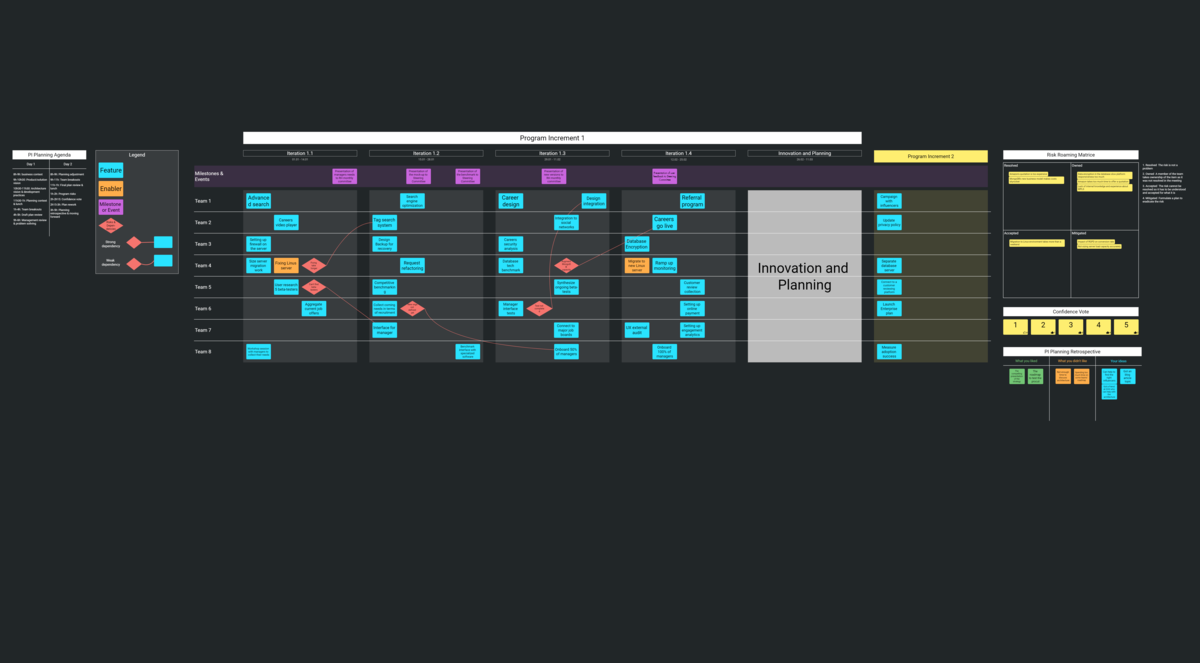What is the PI Planning Board about?
In the Scaled Agile Framework (SAFe), Program Increment (PI) Planning is an important event that takes place at the project level. This is typically called the Agile Release Train in SAFe. Every 10 weeks—the equivalent of five two-week sprints—all Agile team members and stakeholders get together for a two-day workshop to align on the product vision and feature priorities. The PI Planning Board is the medium allowing program managers to both run the event and build the product roadmap (also known as the Program Board).
SAFe was designed specifically to overcome two major challenges that Scrum and Extreme Programming frameworks could not accomplish on their own:
- Extend Agility beyond development alone. In other words, building the strategy, determining and implementing the product’s architecture, allocating resources, and enabling end-to-end testing all in an Agile manner.
- Coordinate all of the Agile teams participating in the development of the same product all at once.
The PI Planning event allows teams to agree on the critical milestones to be respected, identify feature and operational dependencies across all teams, and prevent risks to the program’s overall success. Additionally, the PI Planning event creates a valuable environment where Agile team members and stakeholders can establish a regular and ongoing communication cadence throughout the duration of a product’s lifecycle.

The PI Planning process according to the Scaled Agile organization.
The standard inputs for the PI Planning event are:
- The business context, normally presented by the business owner, which provides a brief overview of current business challenges and overarching Program goals.
- The high-level roadmap, which includes an updated Program vision.
- The top 10 priority features of the Program Backlog to be addressed in the coming months.
At the end of the PI Planning event, the desired outcomes are typically twofold:
- Committed PI Objectives: The features determined by each team, including their corresponding business value, to be addressed over the next 10 weeks.
- The Program Board: This allows program managers to create alignment around each team’s plans, identify dependencies, and determine key milestones.
How to build a comprehensive PI Planning Board?
The typical PI Planning Board includes the following components:
- The PI Planning event agenda
The Program Board
- The Risk Roaming Matrix: A tool used to identify, assess, and mitigate program risks.
- The Confidence Vote: An opportunity for all Agile team members to express their opinion about the roadmap’s feasibility for the next Program Increment.
- The PI Planning Retrospective: A tool used to collect ongoing feedback from Agile team members to improve future PI Planning events.
The PI Planning Board can also be linked to each team’s individual boards—where they independently establish their own plans, identify the objectives and business value of their part of the program, and assess any of their own risks and potential obstacles.
Suggested resources to know more about PI Planning
- The Scaled Agile organisation introduction to PI Planning.
- Insightful Ahmed Syed's 5 Top Tips for an effective SAFe PI Planning on the YouTube channel ‘SAFe in the Real World’.
